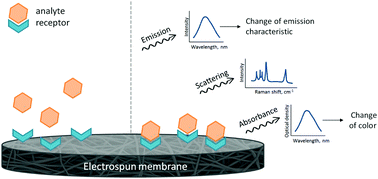Electrospun membranes are highly porous and have a large specific surface area. Their composition and morphology can be modified by multi-component blending and post-spinning modifications. These properties make electrospun membranes prospective for chemical and biological sensing. This article reviews the current achievements in the development of optical sensors based on electrospun membranes (OSBEMs). The analytes detected by these sensors can vary from metal ions to explosives and from glucose to whole cells. Most detection systems are based on colorimetry or fluorescence (including aggregation-induced emission). Some OSBEMs demonstrate promising advantages over the conventional sensors in terms of the detection limit, dynamic range, and analysis time.

